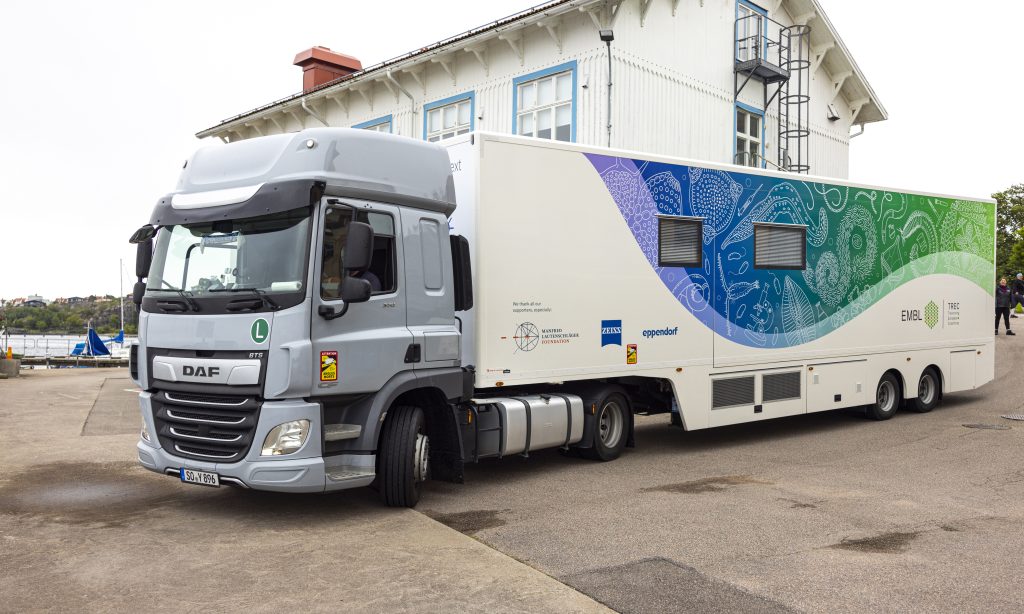Read the latest Issue
ALPX – smart crystallography
ALPX has become the latest spinoff company from EMBL Grenoble. It offers fully automated and remote-controlled protein-to-structure pipelines for protein crystallography and fragment and compound screening. The ALPX high-throughput services enable researchers to solve crystal structures faster, thus accelerating research in a range of fields from pharma to biotech. The spinoff was launched with the assistance of EMBL’s technology transfer arm, EMBLEM.

EMBL spinoff ALPX provides technology to accelerate drug development
Macromolecular crystallography has undergone an era of automation in the past two decades, which has revolutionised both crystallisation procedures and the use of beamlines. However, the important step of crystal harvesting has resisted that trend and remained a relatively slow manual process that could impact crystal quality. To address these shortcomings, scientists at EMBL Grenoble developed the CrystalDirect® technology as well as the web-based Crystallographic Information Management System (CRIMS) software. In combination they form the technological core of ALPX and enable a fully automated, remote-controlled protein-to-structure pipeline that can be piloted remotely from any computer anywhere.
X-ray crystallography is still widely used to support drug design programmes in the pharma and biotech sectors. To do this, large numbers of crystals have to be produced, drug-like compounds added to them, followed by analysis using X-rays. While many steps in the process have been automated, crystal harvesting remains a manual and hence time-intense process. In addition, the manual process involves shipping samples from labs to synchrotron facilities and the transfer of large amounts of data.
The ALPX concept combines automated crystal mounting with the CRIMS software to interconnect each of the steps in an automated way. “We can now access crystal structures faster than ever before – each cycle is done in days rather than weeks or months. This is opening up new possibilities for both structural biologists and medicinal chemists,” says Irina Cornaciu, ALPX CEO, co-founder of ALPX and a scientist at EMBL Grenoble, who helped to develop the new technology. “Virtually, we are making a highly automated crystallisation facility and a synchrotron facility available to scientists from their desktop computers.”
“Structure-based drug design, which describes the development of new medications based on knowledge of the structure of the biological target, is essential in modern drug development. This targeted approach greatly reduces the cost and time for drug research, so new medications can be developed with less money and reach the market, and, ultimately the patient, earlier,” says Gábor Lamm, Managing Director of EMBLEM.
The era of smart crystallography
In 2008, two researchers from EMBL Grenoble – Florent Cipriani and Jose Marquez – began growing crystals directly on a support compatible with subsequent data collection. This led to the establishment of the CrystalDirect® concept, which uses a robotic system developed at EMBL Grenoble to perform the necessary tasks.
In the CrystalDirect® pipeline, crystals are grown on specialised plates – also developed at EMBL Grenoble – which are covered with a thin film on the bottom. The CRIMS software monitors the complete workflow and automatically analyses the data. The software allows researchers to take a look at the crystals on a computer screen and choose the best ones for further processing with CrystalDirect®. It also communicates with multiple synchrotrons in Europe to support automated and remote data collection.
“Not only is our approach much faster and more precise than harvesting by hand, it also prevents damage to the crystals, which often happens during manual handling. Our approach therefore ensures a higher crystal quality,” explains Jose Marquez, the head of the crystallisation facility at EMBL Grenoble and co-founder of ALPX.
Using the CRIMS software all steps can be controlled by scientists from their personal computer from anywhere in the world. This means that crystal measurements can be carried out without delays resulting from physical access to synchrotrons or the shipping of samples.
ALPX is born
The CrystalDirect®technology has been widely adopted and validated for research across EMBL’s sites and further developed and refined over many years. During the entire development process, EMBLEM has been working side by side with the scientists behind CrystalDirect® and CRIMS. “EMBLEM not only took care of securing intellectual property rights, such as patents, trademarks, and copyrights associated with the technology, but also helped to establish CrystalDirect® services for industrial partners,” says Jürgen Bauer, Deputy Managing Director of EMBLEM.
“Over the course of a few years, the attention and requests for services from third parties has increased to a level where spinning out the commercial CrystalDirect® services into a separate company became the logical next step,” says Irina Cornaciu. “ALPX enables rapid and timely access to crystal structures for our partners, opening up new possibilities for medicinal chemistry.”
The European Commission funded iNEXT programme has been instrumental in prototyping the services and in promoting interactions with industry, which eventually led to the creation of ALPX.
ALPX, spin-off de l’EMBL, propose une technologie permettant d’accélérer le développement de médicaments
ALPX est la dernière société créée par essaimage par le Laboratoire européen de biologie moléculaire (EMBL) à Grenoble. Elle propose des pipelines entièrement automatisés et télécommandés couvrant l’ensemble du flux de travail de la protéine à la structure, pour la cristallographie de protéines et le criblage de fragments et de composés. Leurs services à haut débit permettent d’accéder plus rapidement aux données structurales, accélérant ainsi la recherche dans de nombreux domaines de la pharmaceutique à la biotechnologie. L’entreprise a été lancée avec l’aide de la branche de transfert de technologie de l’EMBL, EMBL Enterprise Management Technology Transfer GmbH (EMBLEM).
La cristallographie moléculaire a connu une ère d’automatisation au cours des deux dernières décennies, révolutionnant à la fois les laboratoires de cristallisation et les lignes de lumière. Cependant, l’étape importante de la récolte des cristaux a résisté à cette tendance et est restée un processus manuel relativement lent pouvant impacter la qualité des cristaux. Pour répondre à ces besoins, des scientifiques de l’EMBL Grenoble ont développé la technologie CrystalDirect® et le logiciel en ligne Crystallographic Information Management System (CRIMS). Combinés, ils constituent le cœur technologique d’ALPX et donnent accès à un pipeline entièrement automatisé et contrôlé à distance, couvrant l’ensemble du flux de travail de la protéine à la structure.
La cristallographie par rayons X est encore largement utilisée pour soutenir les programmes de conception de médicaments dans les secteurs pharmaceutique et biotechnologique. Pour ce faire un grand nombre de cristaux doivent être produits, auxquels des composés – potentiels médicaments – sont ajoutés, puis l’ensemble est analysé aux rayons X. Bien que de nombreuses étapes du processus aient été automatisées, la récolte des cristaux reste un processus manuel et donc long. En outre, le processus implique l’expédition d’échantillons depuis chaque laboratoire vers les installations synchrotron et la récupération de grandes quantités de données.
Le concept d’ALPX combine le montage automatisé des cristaux avec le logiciel CRIMS pour interconnecter chacune des étapes. “Nous pouvons maintenant accéder aux structures cristallines avec une rapidité sans précédent – chaque cycle se fait en quelques jours plutôt qu’en plusieurs semaines ou mois. Cela ouvre de nouvelles possibilités aux biologistes structurels et aux chimistes médicaux”, déclare le Dr Irina Cornaciu, PDG d’ALPX et scientifique à l’EMBL Grenoble, qui a contribué à la mise au point de cette nouvelle technologie. “Nous mettons à la disposition des scientifiques un service de cristallisation hautement automatisé et un synchrotron, auxquels ils peuvent accéder à distance depuis leurs ordinateurs”.
“Le développement de nouveaux médicaments grâce à la connaissance de la structure de la cible biologique est une stratégie essentielle au développement moderne de médicaments. Cette approche ciblée permet de réduire considérablement le coût et le temps consacrés à la recherche sur les médicaments, de sorte que les nouveaux médicaments peuvent être développés avec moins d’argent et atteindre le marché, et donc le patient, plus tôt”, déclare Gábor Lamm, directeur général d‘EMBLEM.
L’ère de la cristallographie intelligente
En 2008, deux chercheurs de l’EMBL Grenoble – Florent Cipriani et José Márquez – ont commencé à cultiver des cristaux directement sur un support compatible avec les étapes ultérieures de collecte de données. Cette méthode est à l’origine du concept CrystalDirect®, qui utilise un système robotique développé à l’EMBL Grenoble pour effectuer les tâches nécessaires.
Dans le pipeline CrystalDirect®, les cristaux sont cultivés sur des plaques recouvertes d’une fine pellicule spécialement développées à l’EMBL Grenoble. Le logiciel CRIMS surveille l’ensemble du processus et analyse automatiquement les données. Le logiciel permet aux chercheurs d’examiner les cristaux sur un écran d’ordinateur, de sélectionner les meilleurs pour une analyse ultérieure avec CrystalDirect®. Il communique également avec plusieurs synchrotrons en Europe pour permettre une collecte des données automatisée et à distance.
“Non seulement notre approche est beaucoup plus rapide et précise que la récolte à la main, mais elle permet également d’éviter d’endommager les cristaux, ce qui arrive souvent lors de la manipulation manuelle. Notre approche garantit donc une meilleure qualité des cristaux”, explique le Dr José Márquez, responsable de l’installation de cristallisation de l’EMBL de Grenoble et co-fondateur d’ALPX.
En utilisant le logiciel du CRIMS, toutes les étapes peuvent être contrôlées par les scientifiques depuis leur ordinateur personnel, où qu’ils soient dans le monde. Ainsi, les mesures des cristaux peuvent être effectuées sans les delais résultant de l’accès physique aux synchrotrons ou de l’expédition des échantillons.
ALPX est née
La technologie CrystalDirect® a été largement adoptée et validée pour la recherche sur les sites de l’EMBL, puis développée et perfectionnée au fil des ans. Tout au long du processus de développement, EMBLEM a travaillé au côté des scientifiques à l’origine de CrystalDirect® et du CRIMS.
“EMBLEM s’est non seulement occupée de la sécurisation des droits de propriété intellectuelle, tels que les brevets, les marques déposées et les droits d’auteur associés à la technologie, mais a également contribué à la mise en place des services CrystalDirect® pour les partenaires industriels”, déclare Jürgen Bauer, directeur général adjoint d’EMBLEM.
“En quelques années, l’attention et les demandes de services de la part de tiers ont augmenté à tel point qu’il est devenu logique de transférer les services commerciaux CrystalDirect® dans une société distincte”, explique Irina Cornaciu. “ALPX permet à nos partenaires d’accéder rapidement et en temps utile aux structures cristallines, ce qui ouvre de nouvelles possibilités pour la chimie médicinale”.
Le programme iNEXT, financé par la Commission européenne, a contribué au prototypage des services et à promouvoir les interactions avec l’industrie, ce qui a finalement conduit à la création d’ALPX.







